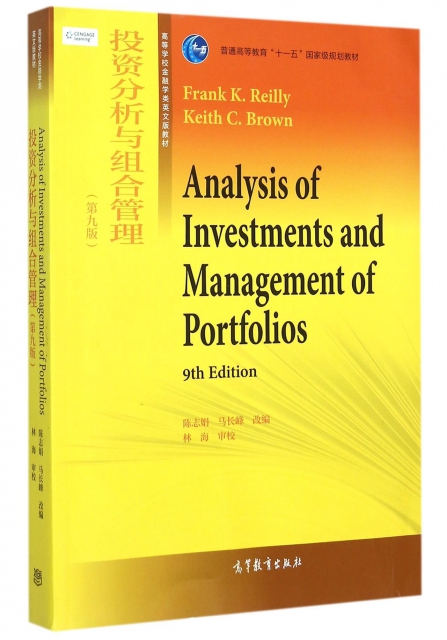| | | | 投資分析與組合管理(第9版高等學校金融學類英文版教材) | | 該商品所屬分類:投資理財 -> 投資指南 | | 【市場價】 | 632-915元 | | 【優惠價】 | 395-572元 | | 【介質】 | book | | 【ISBN】 | 9787040426014 | | 【折扣說明】 | 一次購物滿999元台幣免運費+贈品
一次購物滿2000元台幣95折+免運費+贈品
一次購物滿3000元台幣92折+免運費+贈品
一次購物滿4000元台幣88折+免運費+贈品
| | 【本期贈品】 | ①優質無紡布環保袋,做工棒!②品牌簽字筆 ③品牌手帕紙巾
|
|
| 版本 | 正版全新電子版PDF檔 | | 您已选择: | 正版全新 | 溫馨提示:如果有多種選項,請先選擇再點擊加入購物車。*. 電子圖書價格是0.69折,例如了得網價格是100元,電子書pdf的價格則是69元。
*. 購買電子書不支持貨到付款,購買時選擇atm或者超商、PayPal付款。付款後1-24小時內通過郵件傳輸給您。
*. 如果收到的電子書不滿意,可以聯絡我們退款。謝謝。 | | | |
| | 內容介紹 | |

-
出版社:高等教育
-
ISBN:9787040426014
-
作者:(美)賴利//布朗|改編:陳志娟//馬長峰
-
頁數:662
-
出版日期:2015-07-01
-
印刷日期:2015-07-01
-
包裝:平裝
-
開本:16開
-
版次:1
-
印次:1
-
字數:1040千字
-
賴利、布朗編寫的《投資分析與組合管理(第9版
高等學校金融學類英文版教材)》作為注冊金融分析
師(cFA)資格考試指定用書,是集當代投資理論和分
析技術之大成的投資學的權威教材。本書包括6個部
分,共20章,循序漸進地介紹投資分析和組合管理的
基本內容。其中第1部分和第2部分分別介紹了投資分
析的背景和相關理論。從第3部分開始,從理論過渡
到實踐,具體介紹投資分析中的估值方法和實踐。第
3部分介紹資產估值的基本方法,第4、5部分則是分
別對股票和債券進行分析。第6部分介紹了投資策略
的比較和評價。本書理論闡述新穎,案例分析翔實。
特別適合作為高等學校投資學、金融學、金融工程專
業雙語教學的高年級本科生教材和研究生教材,也可
以作為實際工作者的參考書。
-
PART 1 THE INVESTMENT BACKGROUND
Chapter 1 The Investment Setting
1.1 What Is an Investment?
1.2 Measures of Return and Risk
1.3 Determinants of Required Rates of Return
1.4 Relationship between Risk and Return
Chapter 2 The Asset Allocation Decision
2.1 Individual Investor Life Cycle
2.2 The Portfolio Management Process
2.3 The Need For a Policy Statement
2.4 Input to the Policy Statement
2.5 The Importance of Asset Allocation
Chapter 3 Selecting Investments in a Global Market
3.1 The Case for Global Investments
3.2 Global Investment Choices
3.3 Historical Risk-Returns on Alternative Investments
Chapter 4 Organization and Functioning of Securities Markets
4.1 What Is a Market?
4.2 Primary Capital Markets
4.3 Secondary Financial Markets
4.4 Detailed Analysis of Exchange Markets
PART 2 DEVELOPMENTS IN INVESTMENT THEORY
Chapter 5 Efficient Capital Markets
5.1 Why Should Capital Markets Be Efficient?
5.2 Alternative Efficient Market Hypotheses
5.3 Tests and Results of Efficient Market Hypotheses
5.4 Behavioral Finance
5.5 Implications of Efficient Capital Markets
Chapter 6 An Introduction to Portfolio Management
6.1 Some Background Assumptions
6.2 Markowitz Portfolio Theory
Chapter 7 An Introduction to Asset Pricing Models
7.1 Capital Market Theory: An Overview
7.2 The Capital Asset Pricing Model
7.3 Relaxing the Assumptions
7.4 Additional Empirical Tests of the CAPM
7.5 The Market Portfolio: Theory Versus Practice
Chapter 8 Multifactor Models of Risk and Return
8.1 Arbitrage Pricing Theory
8.2 Multifactor Models and Risk Estimationee
PART 3 VALUATION PRINCIPLES AND PRACTICES
Chapter 9 Analysis of Financial Statements
9.1 Major Financial Statements
9.2 Analysis of Financial Ratios
9.3 Computation of Financial Ratios
9.4 Evaluating Internal Liquidity
9.5 Evaluating Operating Performance
9.6 Risk Analysis
9.7 Analysis of Growth Potential
9.8 Comparative Analysis of Ratios
9.9 The Value of Financial Statement Analysis
9.1o Specific Uses of Financial Ratios
Chapter lo An Introduction to Security Valuation
10.1 An Overview of the Valuation Process
lO.2 Why a Three-Step Valuation Process?
lO.3 Theory of Valuation
lO.4 Valuation of Alternative Investments
lO.5 Relative Valuation Techniques
lO.6 Estimating the Inputs: The Required Rate of Return and the Expected Growth Rate of Valuation Variablesee
PART 4 ANALYSIS AND MANAGEMENT OF COMMON STOCKS
Chapter 11 Macroanalysis and Microvaluation of the Stock Market
11.1 The Components of Market Analysis
11.2 Macromarket Analysis
11.3 Microvaluation Analysis
11.4 Valuation Using the Earnings Multiplier Approach
11.5 Estimating Expected Earnings per Share
11.6 Estimating the Stock Market Earnings Multiplier
11.7 Microvaluation of World Markets
Chapter 12 Industry Analysis
12.1 Why Do Industry Analysis?
12.2 The Business Cycle and Industry Sectors
12.3 Structural Economic Changes and Alternative Industries
12.4 Evaluating the Industry Life Cycle
12.5 Analysis of Industry Competition
12.6 Estimating Industry Rates of Return
12.7 Industry Analysis Using the Relative Valuation Approach
12.8 Other Relative Valuation Ratios
12.9 Global Industry Analysis
Chapter 13 Company Analysis and Stock Valuation
13.1 Company Analysis versus Stock Valuation
13.2 Economic, Industry, and Structural Links to Company Analysis
13.3 Company Analysis
13.4 Estimating Intrinsic Value
13.5 Analysis of Growth Companies
13.6 Measures of Value Added
13.7 Influences on Analysis
13.8 Global Company and Stock Analysis
Chapter 14 Technical Analysis
14.1 Underlying Assumptions of Technical Analysis
14.2 Advantages of Technical Analysis
14.3 Challenges to Technical Analysis
14.4 Technical Trading Rules and Indicators
Chapter 15 Equity Portfolio Management Strategies
15.1 Passive versus Active Management
15.2 An Overview of Passive Equity Portfolio Management Strategies
15.3 An Overview of Active Equity Portfolio Management Strategies
15.4 Value versus Growth Investing: A Closer Look
15.5 An Overview of Style Analysis
15.6 Asset Allocation Strategies
PART 5 ANALYSIS AND MANAGEMENT OF BONDS
Chapter 16 Bond Fundamentals
16.1 Basic Features of a Bond
16.2 The Global Bond Market Structure
16.3 Alternative Bond Issues
16.4 Obtaining Information on Bond Prices
Chapter 17 The Analysis and Valuation of Bonds
17.1 The Fundamentals of Bond Valuation
17.2 Computing Bond Yields
17.3 Calculating Future Bond Prices
17.4 Bond Valuation Using Spot Rates
17.5 What Determines Interest Rates?
17.6 Calculating Forward Rates from the Spot Rate Curve
17.7 Term-Structure Theories
17.8 What Determines the Price Volatility for Bonds?
17.9 Yield Spreads with Embedded Options
Chapter 18 Bond Portfolio Management Strategies
18.1 Bond Portfolio Performance, Style, and Strategy
18.2 Passive Management Strategies
18.3 Active Management Strategies
18.4 Core-Plus Management Strategies
18.5 Matched-Funding Management Strategies
18.6 Contingent and Structured Management Strategies
PART 6 SPECIFICATION AND EVALUATION OF ASSET MANAGEMENT
Chapter 19 Professional Money Management, Alternative Assets, and Industry Ethics
19.1 The Asset Management Industry: Structure and Evolution
19.2 Private Management and Advisory Firms
19.3 Organization and Management of Investment Companies
19.4 Investing in Alternative Asset Classes
19.5 Ethics and Regulation in the Professional Asset Management Industry
19.6 What Do You Want from a Professional Asset Manager?
Chapter 20 Evaluation of Portfolio Performance
20.1 What Is Required of a Portfolio Manager?
20.2 Composite Portfolio Performance Measures
20.3 Application of Portfolio Performance Measures
20.4 Portfolio Performance Evaluation: Some Extensions
20.5 Factors That Affect Use of Performance Measures
20.6 Evaluation of Bond Portfolio Performance
20.7 Reporting Investment Performance
Glossary
FREQUENTLY USED SYMBOLS
| | |
| | | | |
|




